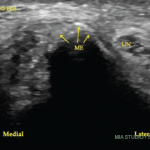When discussing flexible footwear with patients who have medial knee OA, Dr. Shakoor suggests rheumatologists address the following key elements:
- Choose a shoe that can bend in half: This bend test can help patients easily identify if their choice of shoe is flexible enough;
- Avoid a heeled shoe: Based on an investigation of moderately heeled shoes and their impact on the knee, Dr. Shakoor suggests that any type of heel on a shoe can disrupt knee alignment and load distribution;3
- Gait retraining may enhance the benefits of flexible footwear: Not every patient with medial knee OA who switches to flexible footwear feels or displays improvement in their disease, Dr. Shakoor cautions. “A patient may need additional attention to the way they walk to improve alignment of their lower extremities,” she notes;
- A slow progression to a flexible shoe may help some patients: Dr. Shakoor says a very flat, flexible shoe may be a big change from what a patient is used to. “If this is the case, the patient may want to start wearing a flexible shoe for limited time [frames] and slowly build up wear time once the shoe feels more comfortable,” she says; and
- Patients with foot OA and lateral knee OA may need different support: The research on flexible footwear has been done on people with medial knee OA. “It’s important to help patients understand that flexible footwear is not the best treatment approach for everyone,” Dr. Shakoor says. “A conversation about footwear is important for all patients with OA, because different biomechanical factors can be at play. The best footwear choice a patient can make depends on the patient and type of OA.”
Carina Stanton is a freelance science journalist based in Denver.
ad goes here:advert-1
ADVERTISEMENT
SCROLL TO CONTINUE
References
- Shakoor N, Lidtke RH, Wimmer MA, et al. Improvement in knee loading after use of specialized footwear for knee osteoarthritis: Results of a six-month pilot investigation. Arthritis Rheum. 2013;65(5):1282–1289.
- Shakoor N, Sengupta M, Foucher KC, et al. Effects of common footwear on joint loading in osteoarthritis of the knee. Arthritis Care Res (Hoboken). 2010 Jul;62(7):917–923.
- Kerrigan DC, Johansson JL, Bryant MG, et al. Moderate-heeled shoes and knee joint torques relevant to the development and progression of knee osteoarthritis . Arch Phys Med Rehabil. 2005 May;85(5):871–875.
ad goes here:advert-2
ADVERTISEMENT
SCROLL TO CONTINUE
Additional Resources
-
- Read more about Dr. Shakoor’s research on contributors to knee load redistribution using flexible footwear.
- Learn more about research at Rush University Medical Center on a smart shoe insole for patients with knee OA.
- Read about joint loading and footwear in elderly women with knee OA.


